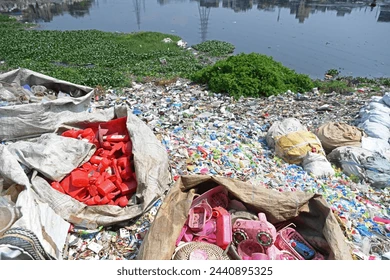Context:
India is the top plastic polluter, emitting 9.3 million tonnes annually, or about one-fifth of global emissions, according to new study published in the journal Nature.
Key finding of study
- India burns roughly 5.8 million tonnes (mt) of plastic each year, and releases another 3.5 mt of plastics into the environment (land, air, water) as debris.
- Nigeria and Indonesia are the second and third largest polluters, with 3.5 million tonnes and 3.4 million tonnes respectively, while China ranks fourth.
- 69% (35.7 million tonnes) of the world’s plastic waste annually comes from 20 countries.
- High-income countries generate more plastic waste but rank outside the top 90 polluters due to 100% collection coverage and controlled disposal.
- On a per-capita basis, China ranks 153rd and India 127th, despite being high absolute emitters, reflecting significant population sizes and varying waste management systems.
Plastic emissions: It includes materials that have moved from controlled systems for waste, however basic, managed or mismanaged, to the environment where they are under no control.
Managed Waste: This is plastic waste collected by municipal bodies, which is either recycled or sent to landfills.
Unmanaged Waste: This includes plastic that is burned in open, uncontrolled fires, releasing fine particulates and toxic gases such as carbon monoxide.
- Uncollected waste is the largest source of plastic pollution in the Global South, accounting for 68% of plastic waste and 85% of debris emissions.
- In high-income countries, littering is the major source of plastic emissions, contributing 53% of debris emissions and 49% of all plastic emissions in the Global North.
Reasons for Plastic Pollution in India
- Population Growth and Affluence: India’s large and growing population, coupled with increasing affluence, leads to more waste. The country struggles to provide adequate waste management services, exacerbating the issue.
- Dumping Sites vs. Landfills: Uncontrolled land disposal in dumping sites is prevalent, outnumbering sanitary landfills by a ratio of 10 to 1.
- Waste Generation and Collection Rates: India’s official waste generation rate is 0.12 kg per capita per day, which may be underestimated, while waste collection is potentially overestimated. The study indicates a more accurate waste collection average of 81%.
- Plastic Waste Burning: Approximately 5.8 million tonnes of plastic waste are openly burned each year in India.
Government Initiatives Toward Plastic Management
- Plastic Waste Management Rules, 2024.
- Swachh Bharat Mission-Urban (SBM-U) 2.0.
- Global Plastic Action Partnership (GPAP).
- World Environment Day.
Conclusion
- The study highlights the urgent need for a global inventory of macroplastic pollution to better inform policies and establish a baseline for researchers. This inventory is vital for the United Nations Plastics Treaty, which could become a binding agreement by year-end. Finalizing the treaty is crucial for advancing global efforts to tackle plastic pollution and requires strong stakeholder support for effective emission reduction strategies.

